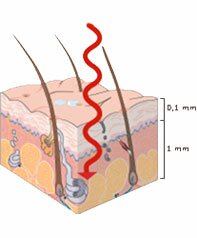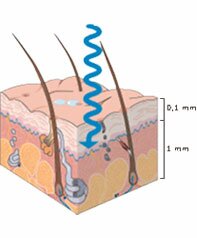UV radiation
The sun provides light, warmth and ultraviolet (UV) radiation. UV radiation can be divided into three groups, UVA, UVB and UVC, according to the wavelengths of the radiation. The energy in the radiation depends on the wavelength; a shorter wavelength has more energetic radiation. To put it in rather simplified terms, we can say that the more energetic the radiation is, the greater the risk of injury.
UVA radiation
UVA radiation has the least energy of the three types UV radiation. Most UV radiation, both from the sun and from solariums, consists of UVA rays. Solariums also usually have a higher percentage of UVA radiation than natural sun. UVA darkens the pigment in the skin. UVA penetrates into the deeper layers of the skin. It causes the skin to age prematurely and can cause skin cancer. UVA radiation can also break down vitamin D in the skin.
UVB radiation
UVB has wavelengths that are shorter than UVA radiation and are thereby more energetic. The ozone layer in the atmosphere filters away much of the harmful parts of the UV radiation and limits the amount of UVB radiation that reaches the earth’s surface. It is primarily UVB radiation that causes us to burn if we get too much sun. It also causes skin ageing and can cause skin cancer. UVB does not penetrate the skin as deeply as UVA. UVB radiation increases the production of certain cells in the skin and makes it thicker. It also increases the amount of pigment in the skin. The thickened skin layer prevents the radiation from penetrating into the tissues. This provides significantly better UV protection than the brown colour alone. Because solariums do not have exactly the same composition of UVA and UVB radiation as the sun, the skin does not develop the same natural protection during solarium tanning. UVB radiation starts the formation of vitamin D in the skin.
UVC radiation
UVC radiation is very energetic. The sun’s UVC rays don’t reach the earth’s surface because all UVC is absorbed by the atmosphere. UVC radiation is used in applications such as special lamps to kill bacteria.


What is your skin type?
The first three skin types are those with the greatest need to protect themselves.
- Skin type 1 is rather uncommon. A typical skin type 1 person has very fair skin, red hair, always burns the first time in the sun and almost never tans. If you have type 1 skin, it is recommended that you always protect yourself from the sun with clothing and sunscreen.
- Skin type 2 has light skin, blond hair, often burns and then occasionally tans. People with this skin type should also exercise great caution in the sun.
- Skin type 3 has light skin, often brown hair, burns sometimes and always tans.
- Skin type 4 has dark brown eyes and dark brown or black hair, seldom burns and tans easily.
- Skin type 5 has naturally dark skin and black hair, never burns and tans easily. • Skin type 6 has naturally very dark skin and black hair, never burns and tans easily.
Smartsun is specially designed for skin type 1 and 2.
source: Information from Swedish Radiation Safety Authority

